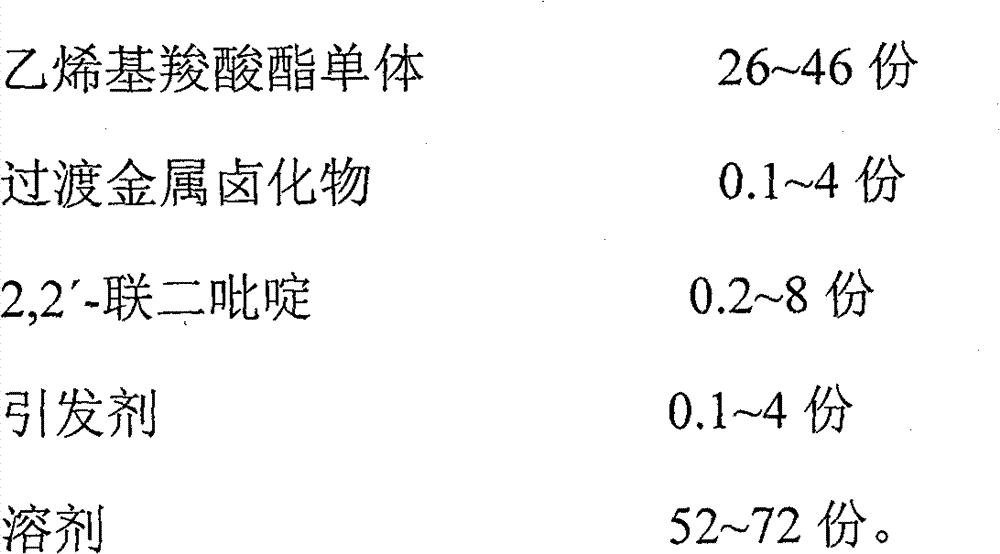Preparation method for efficient calcium carbonate dispersing agent
A dispersant, calcium carbonate technology, applied in chemical instruments and methods, dyed polymer organic compound treatment, fibrous fillers, etc., can solve the problems of lower utilization efficiency of dispersant and precipitation
- Summary
- Abstract
- Description
- Claims
- Application Information
AI Technical Summary
Problems solved by technology
Method used
Image
Examples
Embodiment 1
[0026] Preparation of sodium polyacrylate with low molecular weight and narrow distribution:
[0027] Add 4.45g of CuCl to the reaction kettle, add 300g of toluene after sufficient nitrogen to drive away oxygen, stir and mix, continue to pass nitrogen for 30 minutes, then add 14g of 2,2'-bipyridine, and raise the temperature to 50°C for 1 hour under the protection of nitrogen. A homogeneous complex solution was obtained.
[0028] A mixture of 320 g of tert-butyl acrylate monomer and 4.9 g of ethyl bromide initiator was added, the temperature was raised to 100° C., and the mixture was reacted with nitrogen at constant temperature for 5 hours. After passing through the alumina column to remove the transition metal halides, the resulting solution was mixed with 70 g of sodium hydroxide solution (32% by weight), and then hydrolyzed at 120° C. for 3 hours to convert tert-butyl polyacrylate into sodium polyacrylate. The solvent and tert-butanol by-product were distilled off. Add 5...
Embodiment 2
[0031] Preparation of sodium polymethacrylate with low molecular weight and narrow distribution:
[0032] Add RhCl to the reactor 2 8.46g, add 350g of benzene after sufficient nitrogen to drive oxygen, stir and mix, continue to pass nitrogen for 30 minutes, then add 26.6g of 2,2′-bipyridine, raise the temperature to 50°C under the protection of nitrogen and react for 1 hour to obtain a uniform complex solution . A mixture of 355 g of tert-butyl methacrylate monomer and 9.31 g of ethyl bromide initiator that has been driven by nitrogen to drive oxygen was added, the temperature was raised to 100° C., and the mixture was reacted by nitrogen at a constant temperature for 5 hours. After passing through the alumina column to remove the transition metal halide, the resulting solution was mixed with 70 g of sodium hydroxide solution (weight concentration 32%), and then hydrolyzed at 140 ° C for 4 hours to convert poly-tert-butyl methacrylate into polymethacrylic acid sodium. The ...
Embodiment 3
[0035] Preparation of low molecular weight narrow distribution poly(sodium acrylate-co-sodium methacrylate):
[0036] FeCl was added to the reactor 2 6.23g, add 350g of ethyl acetate after sufficient nitrogen to drive away oxygen, stir and mix, continue to pass nitrogen for 30 minutes, then add 19.6g of 2,2′-bipyridine, raise the temperature to 50°C under the protection of nitrogen and react for 1 hour to obtain a uniform compound substance solution. Add a mixture of 337.5 g of tert-butyl methacrylate and tert-butyl acrylate monomer mixture and 6.86 g of ethyl bromide that have been driven by nitrogen to drive oxygen, raise the temperature to 100° C., and react with nitrogen at a constant temperature for 5 hours. After the transition metal halides were removed through an alumina column, the resulting solution was mixed with 70 g of a sodium hydroxide solution (32% by weight), and then hydrolyzed at 120° C. for 5 hours to convert the copolycarboxylate into sodium polycarboxyl...
PUM
| Property | Measurement | Unit |
|---|---|---|
| polydispersity index | aaaaa | aaaaa |
| polydispersity index | aaaaa | aaaaa |
| polydispersity index | aaaaa | aaaaa |
Abstract
Description
Claims
Application Information
 Login to View More
Login to View More - R&D
- Intellectual Property
- Life Sciences
- Materials
- Tech Scout
- Unparalleled Data Quality
- Higher Quality Content
- 60% Fewer Hallucinations
Browse by: Latest US Patents, China's latest patents, Technical Efficacy Thesaurus, Application Domain, Technology Topic, Popular Technical Reports.
© 2025 PatSnap. All rights reserved.Legal|Privacy policy|Modern Slavery Act Transparency Statement|Sitemap|About US| Contact US: help@patsnap.com

